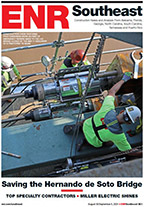At a seasonally adjusted annual rate of $376.1 billion, new construction starts in May dropped 6% from the previous month, according to McGraw-Hill Construction, a division of The McGraw-Hill Cos. Nonresidential building pulled back after its improved level in March and April, while residential building stayed weak.
The nonbuilding construction sector showed moderate growth in May, as a strong gain for electric utilities offset a loss of momentum for public works. During the first five months of 2011, total construction starts on an unadjusted basis came in at $155.2 billion, down 9% from the same period a year ago.
The May statistics produced a reading of 80 for the Dodge Index (2000=100), compared to a revised 84 for April.
“The pattern of construction starts continues to hover at a low volume, providing little evidence to this point that renewed expansion is taking hold,” stated Robert A. Murray, vice president of economic affairs for McGraw-Hill Construction.
“The current year has seen a few bright spots, such as gains for multifamily housing, manufacturing plants and electric utilities. In general, though, the parts of the construction industry that are most likely to see growth in the early stages of a cyclical upturn, such as single-family housing and commercial building, have either wavered or at best shown only intermittent gains. At the same time, the parts of the construction industry dependent on public financing, such as institutional building and public works, have weakened further. The result is that the current period of ‘bouncing along the bottom’ for total construction is becoming more and more extended.”
Nonresidential Building
Nonresidential building in May plunged 12% to $138.7 billion (annual rate), reflecting decreased activity for a majority of the nonresidential structure types. On the institutional side, transportation terminal work in May plummeted 59% after a robust April, which had been lifted by the start of a $1.2-billion airport terminal renovation and expansion at New York’s JFK International Airport.
May did see a few large transportation-related projects reach groundbreaking, such as a $176-million subway station in New York City, but these were smaller in scope than what took place in April. The public buildings category in May weakened 27%, despite the start of a $90-million courthouse expansion in Rockville Md., and amusement-related projects dropped 23%.
A more moderate decline in May was reported for educational buildings, which slipped 7% from April. Large projects that provided some support to May’s amount of educational building included a $175-million university research facility in New York City and a $79-million high school in Katy, Texas.
Health-care construction was one institutional structure type that was able to show greater activity in May, rising 15%. May included the start of four large hospital or medical center projects valued each at $100 million or greater, located in Colorado ($299 million), California ($225 million), Florida ($166 million) and Texas ($100 million).
On the commercial side, hotel construction fell 64% in May, compared to April, which included groundbreaking for two hotels valued at $127 million and $108 million, respectively. The largest hotel to reach groundbreaking in May was a $30-million Indian tribe casino hotel in Kinder, La. Office construction in May fell 8%, continuing to retreat
after its elevated pace in March. The largest office project that reached groundbreaking in May was a $130-million FBI office building in Salt Lake City. Store construction in May also fell by 8%, as this structure type continues to languish.
The warehouse category in May was able to jump 39%, helped by the start of two large warehouses for discount retail chains, located in Indiana ($58 million), and Alabama ($48 million). The manufacturing building category in May advanced 35%, helped by the start of a $190-million biofuel plant in Columbus, Miss., a $98-million manufacturer-owned distribution facility in University Park, Ill., and a $75-million battery manufacturing plant in Middletown, Del.
Residential Building
Residential building, at $116.5 billion (annual rate), dropped 7% in May. Single-family housing slipped an additional 2%, as it has generally receded during the early months of 2011. The May slide was due to this behavior by region—the West, down 3%; the Northeast and South Atlantic, each down 2%; and the Midwest and South Central, no change from the prior month. Murray noted, “Although mortgage rates have edged downward, helping to lift affordability, the ongoing decline in home prices in early 2011 has led to more homebuyer uncertainty, which has stalled for now any recovery for single-family housing.”
Multifamily housing in May dropped 25%, retreating after April’s improved activity. The five largest multifamily projects that reached groundbreaking in May were apartment buildings, as opposed to condominiums, and were located in San Diego ($60 million), Weymouth, Mass. ($35 million), Sacramento ($30 million), Austin ($30 million), and Wakefield, Mass. ($30 million).
Nonbuilding Construction
Nonbuilding construction in May grew 5% to $120.9 billion (annual rate), reflecting continued strength for new electric utility projects. The electric utility category in May soared 68%, helped in particular by the start of a $2-billion solar generating station in Gila Bend, Ariz.


Post a comment to this article
Report Abusive Comment